Conservationists release manual on protecting great apes in forest concessions

This is a chimpanzee in the Republic of Congo. A new report from the International Union for Conservation of Nature highlights the plight of great apes in the forest concessions of Central Africa and recommends actions to improve protection for gorillas and chimpanzees in these mixed-used landscapes, according to authors from the Wildlife Conservation Society and other groups.<br><br>Credit: Ian Nichols<br>
While most conservation efforts are focused on protecting great apes and other species in Central Africa's protected areas, a significant area of the region's rainforest used by gorillas and chimpanzees lies outside of these protected areas in lands designated for some form of extractive use.
Extractive activities such as logging and mining and the accompanying road construction and poaching represent significant threats to great apes in the region.
The report—titled Great Apes and FSC: Implementing 'Ape Friendly' Practices in Central Africa's Logging Concessions—is now available through the IUCN website. The authors include: David Morgan of Lincoln Park Zoo and the Wildlife Conservation Society; Crickette Sanz of Washington University in Saint Louis and Lincoln Park Zoo; David Greer of the World Wide Fund for Nature; Tim Rayden and Fiona Maisels of the Wildlife Conservation Society; and Elizabeth Williamson of the Great Ape section of the IUCN/SSC Primate Specialist Group.
“Many of the forests of Central Africa remain outside existing protected areas,” said David Morgan, the lead author of the study. “The survival of gorillas and chimpanzees in these unprotected landscapes depends on balancing the activities of logging and other forms of development with conservation.”
The new report provides logging companies working in Central Africa with a framework for collaboration between forestry and conservation practitioners to establish “ape friendly” practices in forest concessions and mixed-used landscapes. In particular, the report recommends improvements to principles of the Forest Stewardship Council certification system relating to environmental values and impacts, management, monitoring, and protection of high conservation value areas (HCVs). The document serves as a guide for engaging logging companies and their concessions as key partners in the conservation of great apes.
Among the recommendations provided by the authors are: minimize the risk of ape-human disease transmission through educational campaigns and the implementation of forest concession worker health programs and protocols; strengthen law enforcement within forest concessions; designate strictly controlled hunting zones for non-protected species (not including great apes); recommend additional measures to protect tree species important to great apes and other wildlife in forests identified as high conservation value areas; and ensure long-term monitoring of great apes in forest concessions.
“It is critical that logging companies work with wildlife scientists and protected area managers to ensure that great apes are protected and their abundance and distribution monitored throughout timber concessions as well as in the parks and reserves,” said WCS conservation scientist Fiona Maisels. “By incorporating effective stewardship measures into logging practices, we can ensure a future for gorillas and chimpanzees in the forests of Central Africa.”
WCS appreciates the support of the many partners who made this work possible.
Media Contact
More Information:
http://www.wcs.orgAll latest news from the category: Ecology, The Environment and Conservation
This complex theme deals primarily with interactions between organisms and the environmental factors that impact them, but to a greater extent between individual inanimate environmental factors.
innovations-report offers informative reports and articles on topics such as climate protection, landscape conservation, ecological systems, wildlife and nature parks and ecosystem efficiency and balance.
Newest articles

Properties of new materials for microchips
… can now be measured well. Reseachers of Delft University of Technology demonstrated measuring performance properties of ultrathin silicon membranes. Making ever smaller and more powerful chips requires new ultrathin…

Floating solar’s potential
… to support sustainable development by addressing climate, water, and energy goals holistically. A new study published this week in Nature Energy raises the potential for floating solar photovoltaics (FPV)…

Skyrmions move at record speeds
… a step towards the computing of the future. An international research team led by scientists from the CNRS1 has discovered that the magnetic nanobubbles2 known as skyrmions can be…





















